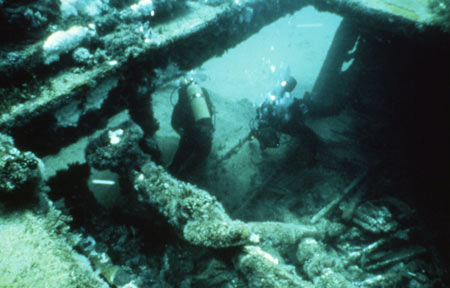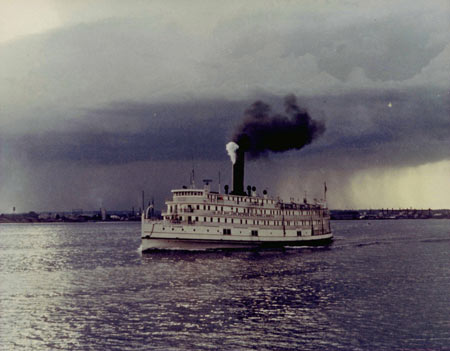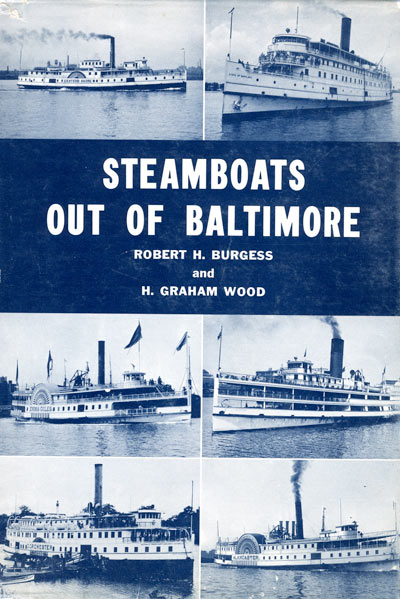‘City’ Beneath the Sea Served Culinary Artifacts

Divers exploring the wreck before its superstructure collapsed
Credit: Wendell Patton
She was projected to become a floating restaurant, hotel and nightclub on a sunny Caribbean island, but Hurricane Hilda sank all the plans…including the ship. The City of Richmond, a beauty in her day, sailed the Baltimore, Maryland, to Norfolk and York River, Virginia, route for 49 years. One of the Baltimore Steam Packet Company’s passenger/cargo carriers—dubbed the Old Bay Line—she was succumbing to faster, cheaper transportation, rising costs and the fading romance of early steamship travel. The 277-foot steel hull liner accommodated more than 300 passengers on three decks and assorted cargo on two others. She and many more including: the City of Norfolk, the City of Annapolis and the District of Columbia served the Maryland, Virginia and Washington regions in days when steamboat travel was fun and fanciful. In addition to passengers and cargo, they carried packets of mail on overnight voyages scheduled 365 days a year. Many fond memories remain for those who were fortunate enough to have sailed aboard one of these Belles of the Chesapeake.
Jack Shaum, former reporter and anchor for Baltimore WBAL Radio for twenty seven and a half years, is retired in Chestertown, Maryland, where he’s writing a book about the Old Bay Line. When completed, his coverage on the City of Richmond will convey more than a passing interest in the vessel. As a frequent passenger over the years, he came close to being aboard on her fatal last cruise. Shaum recalls: “I was supposed to be aboard for the tow to the Virgin Islands. It was the summer of 1964, between my high school graduation and the beginning of college. The new owner, Daniel Price of the Occidental Restaurant, Washington, DC, gave me a job helping load the ship for the trip. I was signed on, but had to cancel in order to start school. Otherwise, I might be writing a first hand account of abandoning ship in the aftermath of a hurricane.”

The City of Richmond sailed for 53 years when steamboat travel was fun and fanciful
Credit: Jack Shaum Archives
Struggling, yet chugging along, the tugboat and survivors found a safe harbor in South Carolina. By the next day, a 20 foot section of the liner’s stack was no longer visible poking through the surface. The owner filed notice of abandonment and the site soon became an underwater habitat and divers’ haven. Sunk in 50 feet of water, the pride of the Old Bay Line sat upright at first, but gradually flattened out by beatings it took from storms and undertow. Wendell Patton, an accomplished east coast diver, told tales of the wondrous artifacts he salvaged, all evidence of the owners’ culinary plans for St. Thomas. Plates, cups, saucers, silverware, pitchers and glasses littered the sandy bottom. Pots, pans, roasters, deep fryers, ovens, mixers and utensils remained crated in the cargo holds. Salvage divers had a field day until the superstructure buckled and sand engulfed the goodies on the scatter trail. Soon spearfishing fans and photographers took over on what became one of the Palmetto State’s most prolific shipwrecks. Today, thousands of silversides, glistening in the 30 to 40 foot visibility, swarm over the wreckage. Nassau groupers hide in cargo holds and colorful tropical fish dupe divers into believing they are in Florida or Caribbean waters. Blue angelfish, queen triggerfish and Atlantic spadefish circle over the superstructure where the three wooden decks have collapsed upon the two steel ones. Amberjack circle the perimeter while barracuda hang motionless nearby. Dusky and sand sharks visit the wreck accompanied by clinging remoras sponging free rides and leftover meals. Although battered and time-worn, some remains are recognizable: cables, winches, anchor chains, stanchions, boilers, beams, ribs, kitchen tiles and a steam engine are scattered over the bottom. A small space—perhaps storage room—is penetrable, but the bulkheads and other passageways have collapsed. The tip of the bow slants to one side in the sand, encircled by schools of mullet and blue-striped grunts. Coral colonies, blanket sponges and sea anemones cling to the remains of the keel.

Books recall fond memories and romance of steamboat travel
Credit: Jack Shaum Archives
The City of Richmond remains a healthy ecosystem supplied by enough sunlight and nutrients to support a thriving community. The wreck is exemplary of something good evolving out of something bad as it provides a happy home for marine life, while remaining a perpetual divers’ delight.
Note: Charterboats, operating out of Myrtle Beach and Georgetown, take divers to the City of Richmond and other wrecks offshore. Capt. Andrew Raak, of Express Water Sports, pilots the 46-foot Scuba Express for Express Water Sports, Murrell’s Inlet, Georgetown. Custom built especially for diving, the Newton model accommodates up to two dozen divers for trips scheduled March through October. For details go to: www.raakbottomimaging.com.
Author: Ellsworth Boyd
Ellsworth Boyd, Professor Emeritus, College of Education, Towson University, Towson, Maryland, pursues an avocation of diving and writing. He has published articles and photo’s in every major dive magazine in the US., Canada, and half a dozen foreign countries. An authority on shipwrecks, Ellsworth has received thousands of letters and e-mails from divers throughout the world who responded to his Wreck Facts column in Sport Diver Magazine. When he’s not writing, or diving, Ellsworth appears as a featured speaker at maritime symposiums in Los Angeles, Houston, Chicago, Ft. Lauderdale, New York and Philadelphia. “Romance & Mystery: Sunken Treasures of the Lost Galleons,” is one of his most popular talks. A pioneer in the sport, Ellsworth was inducted into the International Legends of Diving in 2013.
2 Comments
Submit a Comment
All Rights Reserved © | National Underwater and Marine Agency
All Rights Reserved © | National Underwater and Marine Agency
Web Design by Floyd Dog Design
Web Design by Floyd Dog Design

A fascinating account of the end of an era. There are so few examples of these graceful steamships operating today. Thanks for sharing this story.
Thanks for your kind words. This was an interesting wreck to research. The Old Bay Line launched some beautiful steamships. I regret never traveling on one of them.